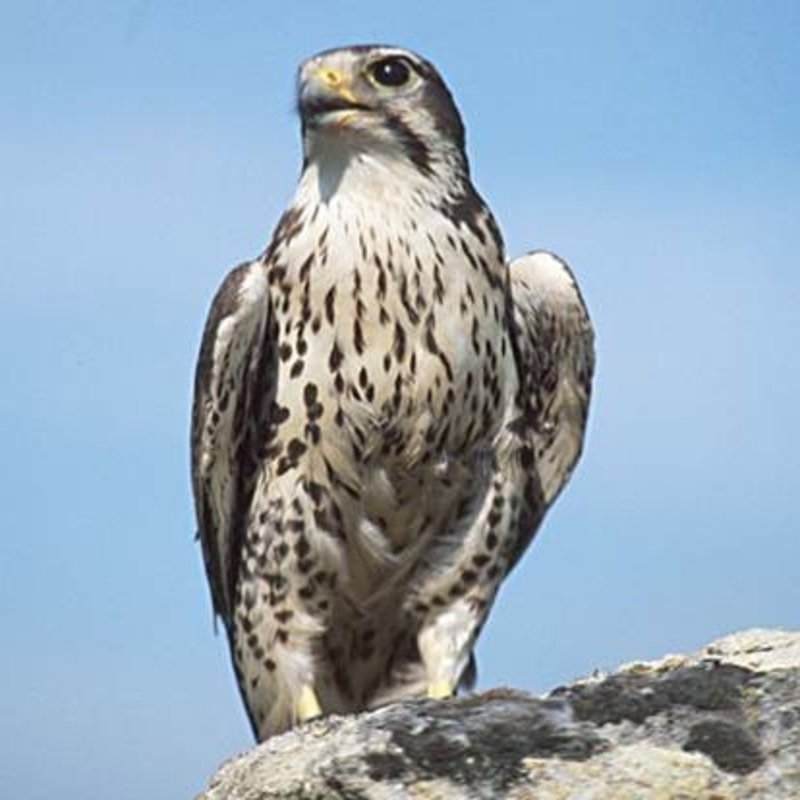In western North America, the prairie falcon, or known in Latin as Falco Mexicanus is a big falcon. Like a peregrine falcon or a crow, it measures 40 cm (16 in) long, has a wingspan of 40 cm (13 in), and weighs 720 g. (1.6 lb). Female falcons are larger than males. The prairie falcon, albeit distinct from the peregrine, is an adaptation of the early peregrine falcon lineage to dry environments, requiring less food and being smaller in weight.
Quick Overview: Falco Mexicanus – Prairie Falcon
Body size: Around 15-19 in (38-48 cm) and a weight of 544 g (19.2 oz)
Main colors: Black, White, Blue, Gold
Range: Western United States
Migratory Bird: No
Best time of the year to see in the U.S.: All Year (January – December)
Conservation Status: Least Concern
Prairie falcon Description
Prairie falcons have big, black eyes and a squarish skull. Face with black malar streaks, dark ear patch, and white patch between eyes and ear patch. A year after birth, the bill horn is dark blue with a golden base. Adults have yellow feet and white necks. Wings are shorter than tail tips when perched. Prairie falcons have black axillaries and a “trailing edge of underwing-coverts”. These stand out against the bird’s pale underwing surface. Prairie falcons may be identified by black triangular patches on the underside of their pale wings.

Size
These birds have a length of 15-19 in (38-48 cm) and a weight of 544 g (19.2 oz). Their wings could range from 40-42 in (102-107 cm).
Feeding
Ground squirrels such as Townsend’s and Belding’s. These falcons consume mourning doves, rose finches, and blackbirds. Then reptiles and large insects.
Habitat
During migration, prairie falcons prefer open grassland, but can sometimes be spotted in woods. A desert or grassland in the winter. Wild grasslands and cliffs are home to prairie falcons.
Behavior
Prairie falcons are loners who only pair up to breed. Prairie falcons have been seen too. Birds were spotted slinging and collecting dried cow manure. Their wingbeats are shallow yet firm. Using their flattened wings and tail, they can fly 4–5 times farther. Prairie falcons spend 4–6% of their day preening. They also bathe in standing water when available. However, the nocturnal flight has been seen by prairie falcons. Most flights are daytime.
Falco mexicanus Scientific Classification
- Kingdom: Animalia
- Phylum: Chordata
- Subphylum: Chelicerata
- Class: Aves
- Order: Falconiformes
- Family: Falconidae
- Genus: Falco
- Species: Falco mexicanus
Best time of the year to see
In the United States, the best time of year to see these birds is all year round, regardless of the season. This refers to any month of the year between January and December.
Distribution of the Prairie falcon in the USA
Prairie falcon is found in the western United States, Mexico, and Canada. It is found in the deserts and prairies of BC, Alberta, and Saskatchewan. These species are found in North Dakota, South Dakota, Texas, Arizona, Nebraska, Kansas, Oklahoma, and New Mexico. Manitoba, Minnesota, Illinois, Iowa, and Indiana have also been reported.
The Prairie falcon can be also found in the following states in the United States – California, Colorado, Idaho, Montana, Nevada, Utah, Washington, and Wyoming.

